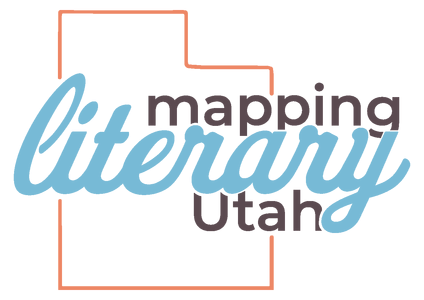Mapping Literary Utah is a not-for-profit web archive of Utah poets and writers, past and present. Created by Paisley Rekdal, Utah’s fifth poet laureate, with the help of a fellowship from the Academy of American Poets and the researchers Maria Alberto and Robert Kennedy, Mapping Literary Utah features the work of native-born Utahns or current residents, as well as of writers who spent a significant period of their creative life in the state.
The purpose of Mapping Literary Utah is to chart the state’s wide-ranging literary landscape through brief author biographies, work samples, photos and video or audio material. Because visitors to the site can find authors by region as well as by name and literary genre, we hope they are encouraged to determine for themselves if there are connections between an author, her creative work and environment, or even between different authors attached to the same place over time.
Mapping Literary Utah is an archive of creative authorship, not a gatekeeper of literary merit. It includes videos of slam poets and oral storytellers. It samples work from experimental, romance, mystery, sci-fi, horror, fantasy, literary, and children’s and young adult literature authors. It gathers together creative nonfiction writers who span the range from eco-critical personal essays to hybrid-genre nonfiction. It celebrates cowboy poets and podcast memoirists, it showcases the historically notable alongside the just-emerging. It embraces the work of bilingual authors and spotlights the work of Utah literary societies.
Still, because an archive must have constraints to remain meaningful as an archive, Mapping Literary Utah does have criteria for an author’s inclusion. For genres or literary practices whose primary convention is publication, writers must have at least one full-length creative work published by a peer-reviewed independent, university, commercial or collective press. Though writers may write in a variety of fields, they must have published at least one full-length creative work. Mapping Literary Utah does not include writers whose sole work is in biography, self-help, history, art history, health, science writing, or journalism since, though these genres may feature literary qualities, they are not meant to be seen as works primarily of imagination or self-invention. The site also does not include authors, like Mark Twain or Thomas Wolfe, who may have set their writing in Utah, but who themselves did not reside in the state. In order to represent as much of the state as fairly as possible, Mapping Literary Utah does not feature writers who resided in Utah solely for graduate educational purposes, as this would heavily skew the archive toward the Wasatch Front. Finally, the site does not feature diaries, letters, hymnals or other documents and genres primarily of familial, spiritual or historic, not literary, intent.
Just as Mapping Literary Utah refuses to make claims about literary merit, however, it does not make claims as to what constitutes a Utah writer. With deceased authors, we select archival entries based on the fact of the author’s birthplace or residence in Utah. With living ones, we invite all those who self-identify as being a resident, current or past, of the state to provide, and write, their own biographical content. No subjects, genres or authorial ethnicity are required to determine regional authenticity; neither are any specific number of years for an author’s state residence. Edward Abbey, who spent relatively little time in Moab, wrote in Desert Solitaire one of the most enduring portraits of Utah, and the West, in contemporary American literature. To deny Abbey a place in this archive would be to deny his cultural impact on Utah, and Utah’s cultural impact on him.
Though no particular subjects, identities, or genres may finally define the Utah writer, occasionally, in our Spotlight section, we group authors around a single theme that they share in common, such as environmental literature. Likewise, we also discuss the role Utah has played in shaping the aesthetic trajectory of particular communities, such as Japanese American authors responding to the legacy of incarceration at Topaz.
Mapping Literary Utah aims to be inclusive, but it cannot be exhaustive. The number of published authors attached to Utah throughout the state’s history is too extensive to be practically realized through a website, as proven by Literary Utah: A Bibliographic Guide created by Utah State University Distinguished Professor, Joyce Kinkead. Interested visitors can visit this catalogue to find more texts and names for independent research. They can also refer to the comprehensive anthology, Great & Peculiar Beauty: A Utah Reader, edited by Thomas J. Lyon and Terry Tempest Williams.
Mapping Literary Utah has gaps and mistakes. Lack of information about certain deceased authors, as well as the loss of their books to time or steep copyright costs for reprinting, made some writers harder to archive than others. Likewise, though writers from around the state in all genres and creative categories were invited to participate, several declined. We do not archive living authors without their explicit consent. Finally, the number of Utah-born or -based authors has exploded, meaning that the site’s editors have had to rely on word-of-mouth or social media for contact with living writers.
Absences are accidental or imposed, not intentional; they are always regretted. Because of this, visitors are encouraged to contact the site editors with comments or suggestions. The hope is that, over time, Mapping Literary Utah’s archive will grow, in that way, reflecting the state’s own dynamic evolution.
